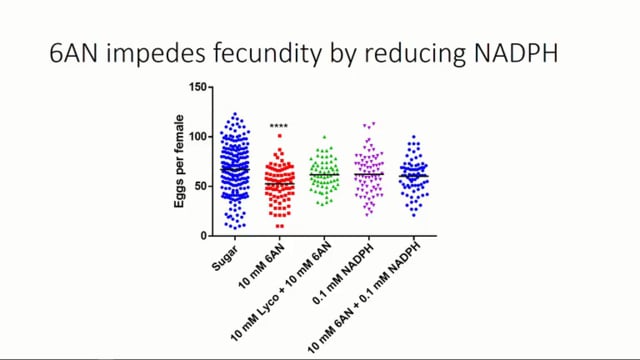ASTMH 2016, Cody J. Champion: “Pentose phosphate pathway inhibition elevates oxidative stress and impedes fecundity in Anopheles gambiae”
Collaborator(s): New Mexico State University, United States
Published: 16/11/2016
In collaboration with ASTMH, Image Audiovisuals, and session presenters, MESA brings you this webcast from the 65th ASTMH annual meeting in Atlanta, November 2016.
Title: “Pentose phosphate pathway inhibition elevates oxidative stress and impedes fecundity in Anopheles gambiae“
Speaker: Cody J. Champion, New Mexico State University, USA
Session information: Scientific Session 130: “Mosquitoes: Biochemistry and Molecular Biology”
Wednesday, 16 November, 10:15am – 12:00pm, Marriott – Room A706 / A707
Abstract:
Blood digestion in hematophagous insects is associated with elevated reactive oxygen species (ROS) resulting from pro-oxidant heme ingestion. Mosquito capacity for defense against oxidative stress is limited and an overabundance of ROS can lead to reduced fecundity and death. Reducing power from internal sources is essential for oxidative stress defense which can impact insecticide sensitivity and defense against pathogens. The primary system used to alleviate oxidative stress is the pentose phosphate pathway (PPP). The major role of PPP is the regeneration of NADPH by reducing NADP+, and 6AN is a competitive inhibitor of G6DPH, the rate-limiting enzyme of PPP. PQ is an exogenous stress inducer, and PPP inhibition results in the accumulation of endogenous stress. We examine the dynamics of oxidative stress by induction by paraquat (PQ), inhibition of the PPP by 6-aminonicotinamide (6AN) and alleviation of oxidative stress by lycopene by oral feeding followed by egg counts and biochemical assessment of females. We hypothesis that PQ and 6AN will induce oxidative stress and result in reduced fecundity. Lycopene should rescue this phenotype by scavenging ROS. Both PQ and 6AN feeding increased oxidative stress levels and decreased fecundity. Co-feeding with lycopene attenuated these adverse effects. 6AN when fed with PQ results in a normal egg number possibly due to inactivation of NADPH production which is required for PQ toxicity. Lycopene also improves 6AN reduction in egg number suggesting that lycopene can alleviate ROS species induced by reducing NADPH production. 6AN reduced NADPH production resulting in a high NADP+:NADPH ratios indicating that the PPP is inhibited by 6AN in our model system. GSSG:GSH ratio also was increased by both 6AN feeding and PQ indicating both of these compounds result in increased oxidative stress. These antioxidants and pro-oxidants can provide a manipulatable link between mosquitoes and egg production capacity. This knowledge can be used to design novel and effective vector control strategies which may influence insecticide sensitivity, infection susceptibility, fecundity and longevity.
THEMES: Basic Science | Vector Control



